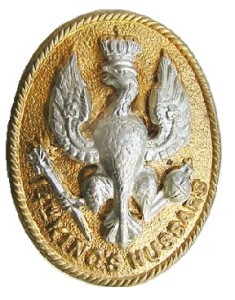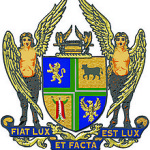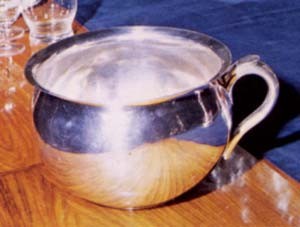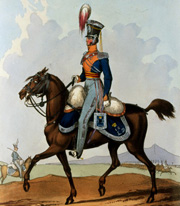14th Dragoons – Raised by Brigadier James Dormer

A portrait of Lieutenant General James Dormer, founder of the 14th Dragoons Regiment, 22nd July 1715
Brigadier James Dormer was an officer who had served with distinction during the War of the Spanish Succession (1701-14). When, in 1715, the Protestant (Hanoverian) King George I ascended to the throne of the United Kingdom, Brigadier Dormer was amongst a number of officers commissioned to raise troops for the King in the face of Roman Catholic rebellion in Scotland (the First Jacobite Rebellion). Dormer’s Regiment of Dragoons was raised in the southern counties.
No sooner was the Regiment raised than it was ordered to march to Preston, in Lancashire, which was threatened by 4,000 rebel troops marching south from Scotland. In the subsequent fighting, the Regiment lost 3 men and 16 horses killed, and Brigadier Dormer was wounded. With the rebels defeated, Dormer’s Dragoons remained stationed in Lancaster, and subsequently in Lincoln.
![Regimental Guidon of the 14th Dragoons in 1758. Plate created and contributed by Richard Couture from a template by [https://www.europeanheraldry.org/ PMPdeL]](https://abercornlodge.com/wp-content/uploads/2015/10/14th_Dragoons_Regimental_Guidon.jpg)
Regimental Guidon of the 14th Dragoons in 1758. Plate created and contributed by Richard Couture from a template by [https://www.europeanheraldry.org/ PMPdeL]
When British troops crossed the Channel at the outbreak of the War of the Austrian Succession (1740–48), Hamilton’s Dragoons were recalled to England. As Roman Catholics again rose in rebellion in Scotland (the Second Jacobite Rebellion), the Regiment marched north to Leith. After Edinburgh fell to the rebels, the Regiment joined Sir John Cope’s army. They were subsequently defeated at Prestonpans, although soldiers of Hamilton’s Dragoons fought a brave defence under Major Richard Bowles. Cope’s troops retreated to Newcastle, where a new commander, Lt. Gen. Henley Hawley, was appointed.
In January 1746, Hawley’s army marched back to Scotland and engaged the rebels at Falkirk Muir (sometimes Falkirk Moor). Partly due to heavy rain which caused the King’s troops’ muskets to misfire, the rebels, with their broadswords, won the battle and the English troops were forced, once again, to retreat. When ‘Bonnie Prince Charlie’s” supporters were finally defeated at Culloden, Hamilton’s Dragoons returned to Ireland in 1747. They remained in Ireland for the next forty-eight years.
A Royal Warrant of 1751 describes the Regiment’s uniform as comprising scarlet coats with lemon coloured facings, black cocked hats with a white loop and a black cockade. Horse decoration was predominantly lemon coloured. At the same time, the Regiment was designated the 14th Regiment of Dragoons. There followed a number of changes of Colonel of the Regiment in quick succession, whilst in 1756, when the Masonic Grand Lodge of Ireland formed a ‘Military Lodge’, the 14th Regiment of Dragoons was chosen to represent Lodge No. 273. The lodge met continuously from 1756 until 1827.
Lodge No. 273 (IC), 1756-1827
In 1756 a Military Lodge was warranted by the Grand Lodge of Ireland and was officially the 14th Dragoons Lodge No. 273. The lodge met continuously from 1756 until Last returns to Grand Lodge of Ireland in 1827. In 1828 they returned to England and to other parts of the world and so ended the lodges connection to Ireland and the Grand Lodge of Ireland. The warrant of the lodge was returned to the Grand Lodge of Ireland in 1827 and the last Master of the lodge was Major John Townsend. The warrant was later re-allocated to the newly formed Abercorn Lodge 273 by the Grand Master, Most Worshipful Brother James Hamilton, 2nd Duke of Abercorn.
Regimental Colours
A Royal Warrant of 1751 describes the Regiment’s uniform as comprising scarlet coats with lemon coloured facings, black cocked hats with a white loop and a black cockade. Horse decoration was predominantly lemon coloured. At the same time, the Regiment was designated the 14th Regiment of Dragoons. There followed a number of changes of Colonel of the Regiment in quick succession.
In 1776, the Regiment, in common with a number of other dragoon regiments, was constituted a ‘light dragoon regiment’, with changes to height requirement for soldiers and the size of the horses, and changes to their equipment. At the same time, the cocked hats were replaced by brass helmets and the Regiment re-designated the 14th Light Dragoons.
In 1784, the clothing for all light dragoon regiments was changed from scarlet coats to dark blue.
At the start of the French Revolutionary Wars (1792-1802), two troops of the 14th Light Dragoons traveled from Ireland to join the Duke of York’s army in Flanders, where they were brigaded with the 8th Light Dragoons. In harsh winter conditions, the Regiment was immediately engaged in skirmishing with the French.
Meanwhile, the war had engulfed the West Indies and the remaining seven troops of the Regiment were ordered to embark for St. Domingo at short notice, travelling without horses. On arrival, they were immediately engaged against irregular French supporters. Disease (mainly cholera), however, ravaged the troops and a meagre 25 men from the Regiment were repatriated to England in 1797. Stationed at Chelmsford, the Regiment recruited and within a few short months regained an establishment of 600 mounted men, divided into eight troops.
In 1798, King George III approved his daughter-in-law, the Princess Royal of Prussia, as patron of the Regiment, which was then named the 14th (Duchess of York’s) Light Dragoons. The colour of the Regimental facings changed from lemon yellow to orange. New carbines and pistols were issued to the Regiment in 1807.
 Late in 1808 the Regiment sailed to Portugal. They remained in Lisbon when Sir John More’s army was evacuated from Corunna, and when British troops returned, under command of Sir Arthur Wellesley (later the Duke of Wellington), the Regiment was brigaded with the 16th and 20th Light Dragoons. Advancing with Wellesley’s army, the Regiment’s first major engagement was at Oporto, and shortly thereafter they fought the Battle of Talavera. In a comparatively minor skirmish at Barquillo, the Regiment suffered 8 men killed and 23 wounded whilst attaching a small French force which had infiltrated British lines. On the approach of a large French army, the Regiment fell back from Almeida covering the British withdrawal. During this time they were in daily contact with the French advance troops until the British reached the defensive lines of Torres Vedras in March 1811.
Late in 1808 the Regiment sailed to Portugal. They remained in Lisbon when Sir John More’s army was evacuated from Corunna, and when British troops returned, under command of Sir Arthur Wellesley (later the Duke of Wellington), the Regiment was brigaded with the 16th and 20th Light Dragoons. Advancing with Wellesley’s army, the Regiment’s first major engagement was at Oporto, and shortly thereafter they fought the Battle of Talavera. In a comparatively minor skirmish at Barquillo, the Regiment suffered 8 men killed and 23 wounded whilst attaching a small French force which had infiltrated British lines. On the approach of a large French army, the Regiment fell back from Almeida covering the British withdrawal. During this time they were in daily contact with the French advance troops until the British reached the defensive lines of Torres Vedras in March 1811.
From the security of Torres Vedras, Wellesley took the offensive and the French withdrew. In March 1811, the 14th Light Dragoons took part in a major battle at Venta de Serra followed by continuous skirmishing as the French fell back towards Fuentes d’Onoro, where another major battle was fought in May and the French driven out of Portugal. The opposing armies advanced and withdrew around Badajoz, which fell to the British in April, 1812. The Regiment fought at Salamanca in July, where the British triumphed. (Shortly thereafter, Corporal William Hanley led a patrol with three privates and four troopers from the King’s German Legion which captured two French officers and twenty-nine French dragoons with their horses). Wellesley subsequently liberated Madrid. The Regiment fought at Vittoria, the battle which effectively ended the French occupation of Spain. The Regiment fought continuous skirmishes as the French withdrew, entering France in November 1813 as part of Wellesley’s advance guard.
The Emperors’ Chamber Pot, 1813
During the Battle of Vittoria in 1813, a patrol of the 14th Light Dragoons became involved in the capture, with the 18th Light Dragoons, of a French Royal Baggage Train. Some attempts were made by British soldiers to ransack the King’s Carriage, but order was restored, and the King’s possessions, documents and looted works of art, were secured and safely handed over to the General Headquarters.
A notable exception to this was King Joseph Bonaparte’s silver chamber pot, engraved with his Coat of Arms, which was secured by the patrol from the 14th because, no doubt, the sight of this particular domestic utensil caused some amusement; no objections seem to have been raised to its retention by its captors.
The Chamber Pot was believed to have been a present to his brother by the Emperor Napoleon, and it came to be known as ‘The Emperor’. Accordingly, within the Peninsula Army, the 14th as its custodians became known as “The Emperor’s Chambermaids”, a nickname which apparently gave much pleasure to the Regiment at the time.
Today, the Commanding Officer traditionally asks officers to drink from the Emperor on Mess nights. It remains the most treasured piece of silver possessed by the Regiment.
Continuous minor engagements were fought as the French retreated, with major battles at Ortes in February, 1814, and at Toulouse in April. Napoleon capitulated, and in July the Regiment was repatriated to England after six years continuous fighting.
1814 saw the 14th (Duchess of York’s) Light Dragoons stationed at Weymouth. Two squadrons of the Regiment were sent to Jamaica from where a half-hearted attack on New Orleans was envisaged, but abandoned. An attack was launched, however, in January 1815, with disastrous results and one entire troop was captured by the Americans. Peace was declared, and the two squadrons rejoined to the Regiment at Hounslow. The absence of a quarter of its establishment overseas meant that the Regiment was not chosen for Wellington’s campaign in Europe.
In 1816, the Regiment returned to Ireland where they were stationed at Cork. They returned to England in 1819 and in the Autumn of that year the Commanding Officer who had guided them throughout the Peninsular Campaign, Col. Sir Felton Hervey, died suddenly. At the same time, the establishment was reduced to six troops.
The 14th Light Dragoons left England for Ireland once more in 1825 and marched to Dublin. After three years, in 1828 they returned to England where they were stationed at Leeds, and thereafter Brighton and Chichester. Marching to London in 1830, to celebrate the coronation of King William IV the name of the Regiment was changed to the 14th (The King’s) Regiment of Light Dragoons. At the same time, the facings of the uniform changed from orange to scarlet.
In October, 1831, the Regiment was required to suppress rioting in Bristol. Thereafter they returned to Hounslow for Royal Escort duties in 1832, and in 1833 they returned to Ireland for four years, and in 1837 they left Belfast for Glasgow, then Edinburgh, then back to Hounslow and thence to Dorchester in 1840.
In May 1841, leaving a depot squadron at Maidstone, the Regiment embarked for India, arriving in Bombay in September. For three years they were stationed at Kirkee, and thence to Agra, Meerut and Umballa in 1846. The Regiment fought at Ramnuggur during the First Sikh War (1845-46) and at Chillianwallah and Goojerat during the Second Sikh War (1848-49), The Regiment at that time had an establishment of some 20 officers, 705 men, and 701 horses.
In 1857, ‘H” Troop from the Regiment joined a British expeditionary force of 5,000 men to Persia (now Iran), embarking at Bombay and disembarking at Bushire. Meanwhile, on the outbreak of the Mutiny, the Regiment was dispersed throughout Northern India to counter local threats. Interestingly, at this time the Regiment adopted turbans to replace their forage caps, the former being more practical in the Indian heat. In June the Regiment (together with the 25th Bombay Native Infantry) marched to the relief of Mhow, and thence to Malwa where they were engaged with rebel troops throughout the latter half of 1857. Throughout 1858 and 1859, the Regiment was active in suppressing rebel forces in northern India with many major engagements.
Returning to England in 1860 (leaving their horses, which included a number of Arabian remounts, in India), the Regiment was renamed the 14th (King’s) Hussars, with new uniforms and busbies featuring yellow busby-bags. Thereafter they were stationed in Ireland, then England where they assumed policing duties during rioting in Manchester in 1862. They returned to Ireland in 1868, and embarked for India (Bangalore) in 1876. After five years at Bangalore, in 1881 the Regiment embarked for South Africa (Transvaal State) sailing from Bombay to Durban to fight the First Boer War (1880-81), but the dispute was peacefully resolved and they returned to India in 1882, relieving the 12th Lancers at Secunderabad. (In Secunderabad in May, 1885, two young officers were killed by lightning whilst playing billiards in the Officers’ Mess).
The 14th (King’s) Hussars were repatriated to England (Shorncliffe) in 1886. They were immediately re-equipped with the new-pattern solid-hilted sword and the Martini-Henry carbine, together with new saddlery. In a comparatively long home posting, the Regiment remained at Shorncliffe for two years. In 1889, the Commanding Officer, Lt. Col. Gilbert Hamilton, ordered that a copy of the Regimental History, or ‘almanack’, be displayed in each barrack room. (In June 1890, Sainfoin, a chestnut colt owned by the Regiment’s adjutant, won the Epsom Derby).
These years saw the Regiment quartered in southern England, notably at Aldershot, Brighton and Hounslow. In 1892, they moved north to Leeds and Birmingham, then Manchester (threatened by coal mining riots). The Regiment formed a Royal Escort when Queen Victoria opened the Manchester Ship Canal (1894), and then crossed the Bristol Channel to Ireland (Cahir, Waterford and Limerick). New carbines, Lee-Metford model, were issued and in 1899 a warning order was issued preparing the Regiment for embarkation to South Africa.
The Regiment sailed from Southampton in December 1899, leaving a depot squadron in Ireland (Curragh). ‘B’ Squadron was immediately committed to the relief of Kimberley in French’s Cavalry Division, whilst ‘A’ and ‘C’ Squadrons marched to the relief of Ladysmith with Burn-Murdoch’s 1st Cavalry Brigade. Fighting was constant and intense. The Regiment was re-united in April and, having lost a huge number of horses, received remounts from Argentine and local Cape ponies, but a stampede resulted in the loss of 53 horses. Guerrilla tactics used by the Boers throughout this period proved very effective and the British cavalry were constantly in action – a Victoria Cross was awarded to Major Edward Brown for his actions at Dalmanutha, near Geluk.
Chronology
- 1715 Raised as as James Dormer’s Regiment of Dragoons and ranked as the 14th Dragoons
- 1751 Formally titled the 14th Regiment of Dragoons
- 1755 Masonic Lodge of the 14th Regiment of Dragoons, Lodge no. 275 (IC) was inaugurated
- 1776 Renamed the 14th Regiment of (Light) Dragoons
- 1798 Renamed the 14th (The Duchess of York’s Own) Regiment of (Light) Dragoons
- 1830 Renamed the 14th (The King’s) Regiment of (Light) Dragoons
- 1861 Renamed the 14th (King’s) Hussars
- 1921 Renamed the 14th King’s Hussars
- 1921 Amalgamated with the 20th Hussars to form the 14th/20th Hussars
- 1992 Amalgamated with the The Royal Hussars (Prince of Wales’s Own) to become The King’s Royal Hussars
Colonels of the Regiment
James Dormer – Appointed 22nd July, 1715.
Clement Neville – Appointed 9th April, 1720.
Archibald Hamilton – Appointed 27th June, 1737.
James Lord Tyrawley – Appointed 24th July, 1749.
Louis Dejean – Appointed 27th November, 1752.
John Campbell – Appointed 5th April, 1757.
Charles Fitzroy – Appointed llth September, 1765.
Daniel Webb – Appointed 20th October, 1772.
George Warde – Appointed llth November, 1773.
Sir Robert Sloper, K.B – Appointed 2nd April, 1778.
John William Egerton – Appointed 1st June, 1797.
Sir John Ormsby Vandeleur, G.C.B – Appointed 28th October, 1823.
Lieut. Colonel John Townsend – Appointed 16th April, 1829
Lieut. Colonel Edward Harvey – Appointed 23rd of April, 1845
Credits & Interesting Links
British Cavalry Regiments of the 19th Century – Ross Barnett 2015
- Maull & Co An officer of the14th Hussars (Public Domain)
- J. Matthews Officers of the 14th King’s Hussars (1889) (14th/20th King’s Hussars Museum)
A List of Military Lodges at Military Masons.org
A History of The Kings Royal Hussars
A Historical Record of the 14th Kings Hussars from 1715 – 1900
A Historical Record of the 14th Dragoons
The Battle of Vitoria Peninsular War 21st June 1813
A History of The 14th Dragoons – Richard Cannon -1779-1865
14th Dragoons – 14/20th Kings Hussars
Historical record of the Fourteenth, or the King’s, regiment of light dragoons:




